|
While Chantal Akerman had been a name in world-cinema terms since the later 1970s, many people were surprised in 2022 when her 1975 film Jeanne Dielman 23, Quai du Carosse 1080 Bruxelles (just Jeanne Dielman from here onwards) took first place in Sight & Sound’s once-a-decade poll of the Greatest Films of All Time. It was the first film directed by a woman to earn that accolade. While previous winners (Bicycle Thieves in 1952, Citizen Kane from 1962 to 2002, Vertigo in 2012) were canonical classics and still are, with Jeanne Dielman topping the poll there was a reaction in many quarters along the lines of, 'What is this?' and many claiming not to have heard of the film. It is fair to say that Jeanne Dielman, in the UK at least, was a film more heard about than actually seen for many many years. It was released in 1979 in 16mm only, its length, and therefore its BBFC certification cost had it been submitted, plus its perceived difficulty, making it a distinctly uncommercial prospect. The film did have showings, including some in the National Film Theatre, but it had not been released in the UK on VHS or DVD. (Criterion in the USA released it on DVD in 2009. That was the first time I saw it, as I reviewed it for the site I was writing for then.) To this date it has not had a showing on UK television. Between 2013 and 2015, the London-based film collective A Nos Amours (founded by Joanna Hogg and Adam Roberts) showed in various London cinemas a complete retrospective of Akerman’s films, culminating in the UK release of her newest (and as it turned out, last) work No Home Movie. Akerman took part in a symposium during this season. Needless to say, such an endeavour was a far more difficult task then than it would be now, with rare prints, perhaps not in the best of condition, having to be sourced and shown, rather than the digital restorations which feature on this box set and make up the bulk of the BFI Southbank’s retrospective in February 2025.
Needless to say, there were accusations of tokenism, of wishing to promote a female director (even more so, a gay Jewish female director) above the old-school great males of the cinema, though the poll was the result of 1639 participants from around the world, all working and voting independently of each other. (Jeanne Dielman received 215 votes, seven more than the number two, Vertigo, so if its win was a result of an agenda, it was an agenda held by one in eight of the electorate.) Jeanne Dielman had, for those who had been looking, a solid place in film history for several reasons: as a feminist film and as an experimental film being two of them. If the original wasn’t then widely shown, films which showed its influence had been released in the decades in between. While she was seen as an important filmmaker in her lifetime, sadly Akerman in 2022 had been dead for seven years.
Chantal Anne Akerman (a form of her name she used occasionally, including on Jeanne Dielman) was born on 6 June 1950 in Brussels, the older daughter of Polish Jewish Holocaust survivors. She was particularly close to her mother Natalia throughout her life, and Natalia encouraged her to pursue a career rather than following the traditional feminine path of marriage and presumably children. Initially aiming to be a writer, at fifteen she saw Godard’s Pierrot le fou, which galvanised her ambitions to be a film director. At the age of seventeen, she applied to the national film school, Institut Supérieur des Arts du Spectacle (INSAS) in Brussels.
| INSAS ENTRANCE EXAM FILMS |
|
Most sources understandably list Saute ma ville (1968) as Akerman’s debut film. However, it was preceded by these four pieces, of just over four minutes each, shot silent in standard 8mm in black and white. They were made in Summer 1967 as Akerman’s entry pieces to INSAS: Bruxelles, Film 1 (4:54), Bruxelles, Film 2 (5:05), Knokke, Film 1 (4:31) and Knokke, Film 2 (4:33). These running times include captions referring to the films’ making and restoration, in both French and Dutch. There is a Play All option. The first Brussels film was shot at the Foire du Midi, and is a view of the attractions and the people wandering among them which verges on the abstract. The second Brussels film shows Akerman’s childhood friend Marilyn Watelet, who saw Pierrot le fou with her and who later jointly founded their production company Paradise Films. Watelet is seen with her mother and sister in the streets and shops and at home washing dishes and fixing their hair. By coincidence, some of this was shot in the grounds of the Hôtel de Clèves-Ravenstein, which is next door to the Royal Film Archive of Belgium (Cinematek) which both houses the Fondation Chantal Akerman and is the source of most of the restorations on these discs.
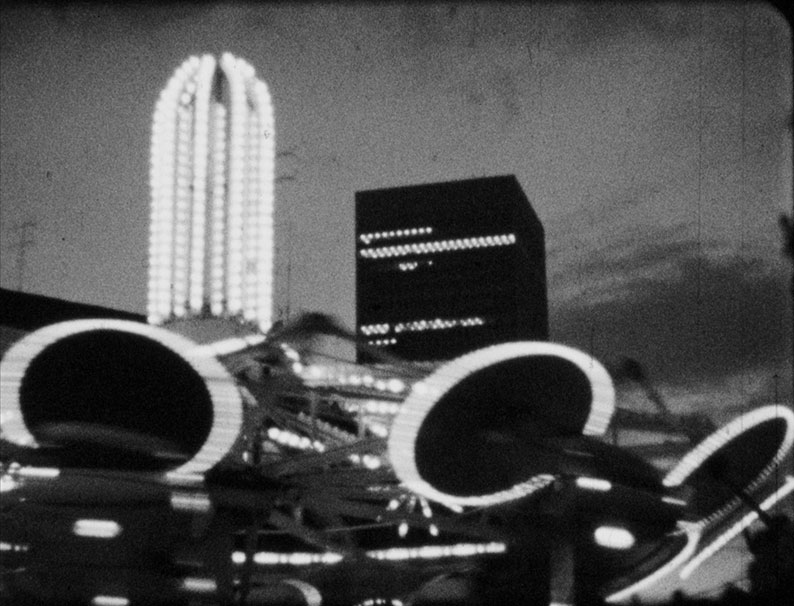
The second two films were shot at the seaside resort of Knokke, and again feature Watelet, with Akerman and Akerman’s mother Natalia making brief appearances. In the first, Watelet goes shopping again, this time for shoes. This isn’t fly-on-the-wall stuff as it’s clear that it’s directed to some extent, but it’s also apparent that this is something of a showcase for the director’s great friend.
Akerman was accepted to INSAS, but didn’t find the school congenial, feeling it was pushing her into more conventional paths than she would have liked. She left after three months.
The four films are presented mute, in an aspect ratio of 1.33:1, with every second frame repeated so as to play at twenty-four frames per second but to preserve the original speed of sixteen fps. They are transferred from the original 8mm materials, so are inevitably soft and at times intensely grainy, with some print damage apparent.
Made after she left INSAS, Saute ma ville (Blow Up My Town) is thirteen-minute short filmed in black and white 35mm with a small crew, made in just one night in November 1968 at Akerman’s family home. She raised the money by selling diamond shares on the Antwerp stock exchange. The film was not shown until 1970 due to Akerman not having the money to process it in the lab. She was so uncertain of its worth that she asked the head of the lab to watch it and advise if it was good enough, or else it would be disposed of. The lab head not only liked it, but he recommended it to contacts he had in Belgian television, resulting in a showing on the small screen and a commendation from the leading Belgian film director André Delvaux,
Akerman is also the only person on screen, as a young woman who arrives at the apartment block where she lives. Most of the action takes place in the small kitchen, as she performs several small tasks. There is no spoken dialogue, but instead a nonsensical sing-song voiceover, which lightens the tone of what is a noticeably dark film, one which takes on a greater resonance in hindsight as we know that Akerman would later take her own life.
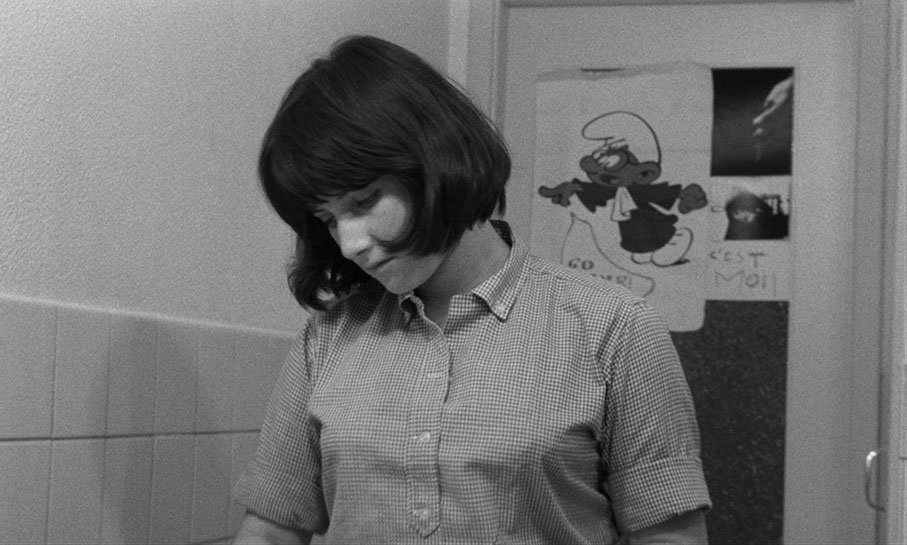
There are a lot of early hints at Akerman’s themes and preoccupations here: the emphasis on specifically feminine domesticity, including scenes and actions that many films would remove as being unimportant. The humour shows the influence of Godard on the eighteen-year-old director.
Saute ma ville was transferred from a 2K scan of the original 35mm negative and is presented in a ratio of 1.66:1. There’s nothing untoward about it: blacks, whites and grey seem true and grain is natural. The menu says that the film is intended to play without subtitles, but there are some available, translating the title and dedication (to Akerman’s then girlfriend Claire Wauthion), a few words the young woman draws on a mirror and the spoken credits at the end. The BFI’s transfer begins with an advisory that it contains a scene of self-harm.
| L’ENFANT AIMÉ, OU JE JOUE À ÊTRE UNE FEMME MARIÉE |
|
Shot in June 1971 in 16mm, L’enfant aimé, ou Je joue à être une femme mariée (The Loved Child, or I Play at Being a Married Woman) was not Akerman’s favourite of her own films. One issue may have been that Jonas Mekas, who had been a supporter of Saute ma ville, was relatively cool on this short film, more than twice as long as its predecessor. Akerman herself thought the film was a failure and for many years did not allow it to be shown. It was also thought to be a lost film, but that was not the case, even though it was absent from retrospectives for many years.
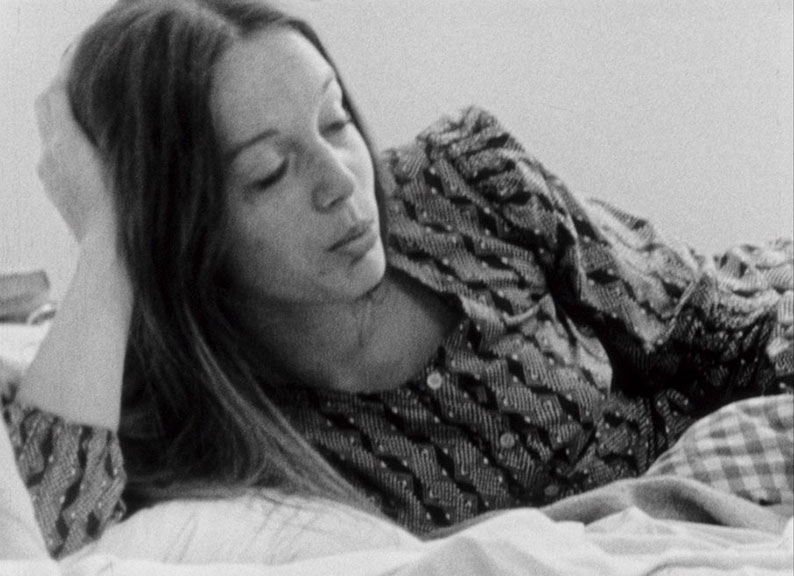
There are three women in the film, one a child (Daphna Merzer), her mother (Claire Wauthion) and the mother’s friend and confidante (Akerman). The film does prefigure Akerman’s later works in its concerns with gender roles and its urge to highlight areas of women’s experience which other films would elide as unimportant and insignificant. In the key scene in the film, the mother, wearing only her knickers, stands in front of a mirror and assesses herself, all the parts of her body, with a critical eye. This scene was later extracted from the film and included as a five-minute segment of one of Akerman’s video installations.
L’enfant aimé… was scanned at 2K resolution from a 16mm duplicate positive and is presented in a ratio of 1.37:1. It’s undeniably soft and grainy, which is no doubt due to its source.
Shortly after making L’enfant aimé…, Akerman relocated to New York, living there from 1971 to 1974, with several trips home during that time. Filmed in 1972 at Akerman’s flat in Spring Street, SoHo, La chambre marks a couple of firsts: Akerman working in colour and also collaborating with French-born, US-based cinematographer Babette Mangolte. Shot on 16mm reversal stock (using a leftover reel from Hôtel Monterey) with no soundtrack, it directly shows the influence of Michael Snow’s films, particularly Wavelength (1967), which had impressed Akerman. It’s not a narrative, but not really a documentary either (Akerman disparaged any distinction between documentary and fiction), but an exploration of space, a personal one, where its director lived at the time, and indeed is seen lying on her bed, eating an apple, gazing at the camera. The film comprises three 360º pans around this space, after the third movement returning back the way it came.
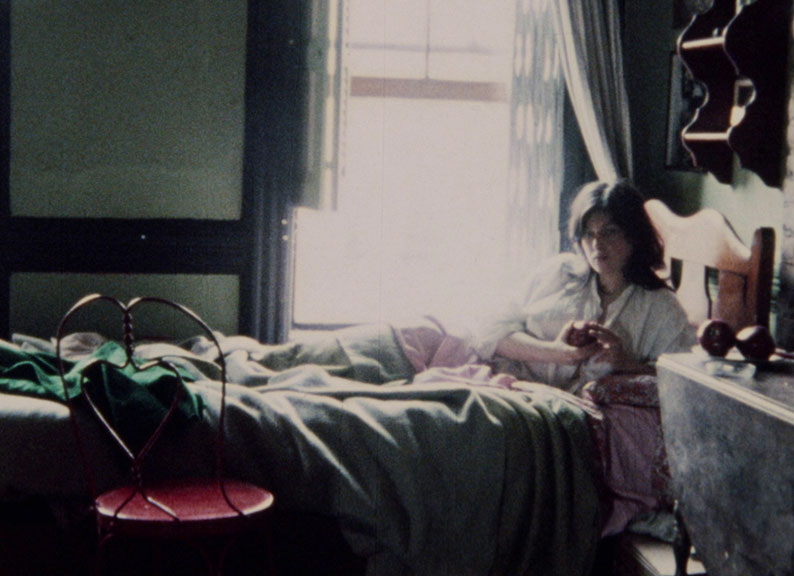
Akerman had arrived in New York in 1971 and kept herself afloat by doing various odd jobs, serving in restaurants and shops and in the box office of an adult cinema. She financed La chambre and Hôtel Monterey from her own savings, though her mother also helped out (see also News from Home, on which Mangolte also collaborated).
La chambre was scanned in 2K from the original 16mm reversal positive and is presented in a ratio of 1.37:1. Again, softness and grain are the watchwords, given the lower-resolution source and minimal lighting, sunlight from the window augmented by mirrors.
Hôtel Monterey was Akerman’s first feature-length film, shot by Babette Mangolte at the hotel of the title on a single evening and night (21 May 1972), over seventeen hours. There is no soundtrack, and Akerman and Mangolte move the camera down corridors, taking in the walls (stained by countless guest handprints, according to Mangolte). At times the camera sits in a lift as people come in and out. Finally we reach the roof and look out over the city as dawn breaks. We do see some of the guests moving about – hardly any of them reacting to the camera, which was presumably hidden for much of the time. The film was shot using available light (neon) with some additional lighting in some of the rooms. Akerman was fascinated by liminal spaces and transient venues, something which particularly comes to the fore during her later feature Les rendez-vous d’Anna. A hotel is just such a space and venue, somewhere to stay for a longer or shorter time but never a home. Preparing to make this film, Akerman stayed in the hotel for a while. It’s a place of many stories, some of which we glimpse, and many memories.
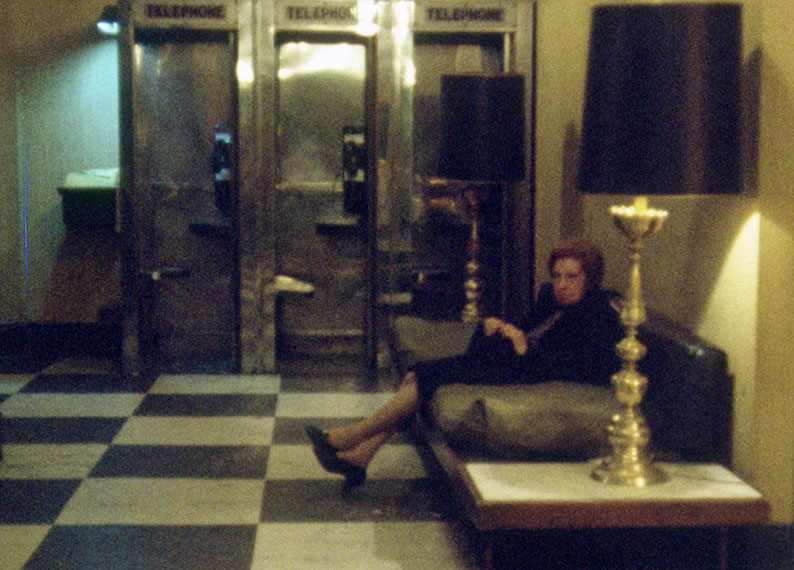
Much of what was said about La chambre applies here too: shot on 16mm reversal stock with available lighting, so it’s soft, grainy and often dark. Presented in a ratio of 1.37:1.
Also part of Akerman’s residence in New York City, Hanging Out Yonkers was an unfinished film, shot in Autumn 1972, again with Mangolte on cinematography duties. This looks behind the scenes at the RAP (Rehabilitation and Prevention) Center in Yonkers, in the north of the city. Accounts vary: either Akerman worked as an assistant there three days a week and the film derived from that, or it was a commission from a friend at the Center. It was shot in 16mm reversal stock. La chambre and Hôtel Monterey were intentionally mute, but that wasn’t the case with this film However, much of the footage and all of the sound reels were lost on the New York subway, so what we have is all that remains. It was kept in the archive and digitised after Akerman’s death. We see the adolescents at the Center sitting together, smoking, chatting (obviously what they say we cannot now know, unless we can lipread), playing chess and pool, almost as if this was an evening at a youth club somewhere. What the film would have been if it had ever been finished is anyone’s guess, though documents suggest that some of the teenagers’ life stories would have appeared on the soundtrack.
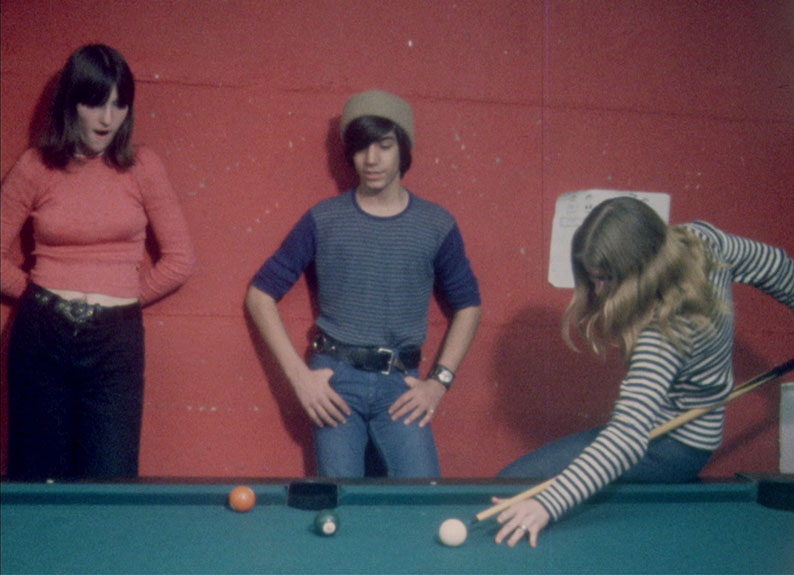
Hanging Out Yonkers is presented in a ratio of 1.37:1 with no sound. There’s nothing untoward about what we see, given the film’s circumstances: colours are strong and grain natural, even though this was, as with its predecessors, likely short largely with available light.
That’s it for Disc One. Disc Two begins with...
The title is a date (15 August), which may have been the day in 1973 when this was filmed. A young Finnish woman in Paris, Chris Myllykoski, takes front and centre, talking about her life. As the film progresses, we sense a disconnect between the rooms she moves through – another domestic space – the sunny days outside, eventually broken by a thunderstorm, and what we hear on the soundtrack, an expression of Chris’s fears and sense of displacement. Given what we know, with hindsight, about Akerman’s experience of depression, you sense she’s empathising with Chris in this film. Chris’s monologue is almost a stream of consciousness, taking in memories of a visit to London and of reading one of the great stream-of-consciousness novels of the twentieth century, Virginia Woolf’s Mrs Dalloway.
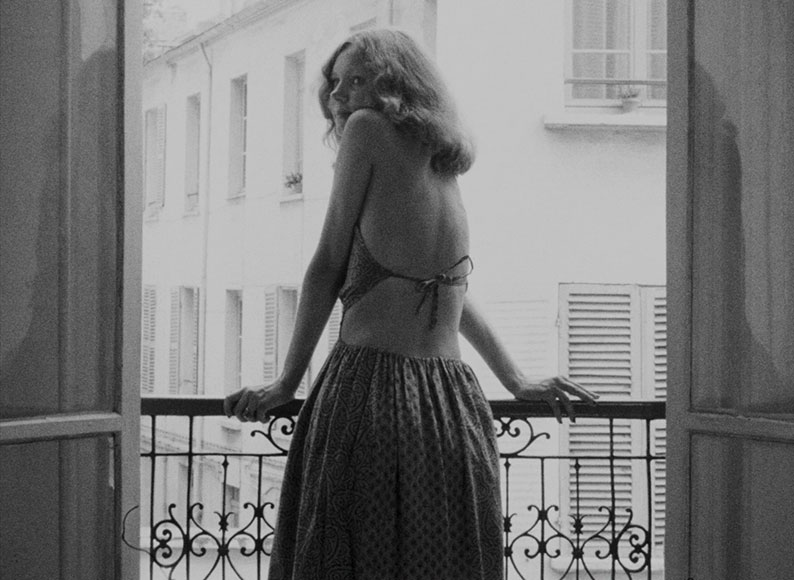
Les 15/8 is unusual in two respects. Chris’s narration is in English, a first for Akerman’s films, though that’s likely due to the language being a lingua franca for a Finn and her francophone director. Or maybe that should be directors: for the first time, Akerman had a collaborator in directing, cinematography and editing, Samy Szlingerbaum, though their names are simply listed without job titles in the opening credits after Chris. Szlingerbaum was born in the same year as Akerman, and his parents were also Holocaust survivors from Poland. He went on to direct one feature film, the Yiddish-language Brussels Transit (1980) and died in 1986.
The film was transferred from a 16mm duplicate negative and positive, scanned in 2K. It is presented in a ratio of 1.37:1.
Akerman’s first dramatic feature was shot quickly, in February and March 1974, when she was twenty-three. It made a virtue of a necessity: as the reels of film she was able to obtain were black and white 35mm, that’s why the film was shot the way it was, though the scenes inside the truck were 16mm and have the grain to show for it. And although I say “dramatic feature”, as it isn’t a documentary, it still engages with ideas of time and duration and the space between people in rooms, or in this case as well inside a moving vehicle. Akerman made it as a calling card so that she might receive funding for the film she wanted to make, Jeanne Dielman, for which Delphine Seyrig was already lined up to play the lead.
In the opening section, we see a young woman (Akerman) in her own flat. She is unnamed, though as Akerman is billed as “Julie” in the credits. I’ll call the character Julie as a shorthand. Julie lies on the mattress that passes for a bed, writes a letter to her girlfriend, scarfs down the contents of a packet of castor sugar. It’s snowing outside. Finally, she leaves the flat and hitches a ride with a truck driver (Niels Arestrup). Following that encounter, she meets her girlfriend (Claire Wauthion).
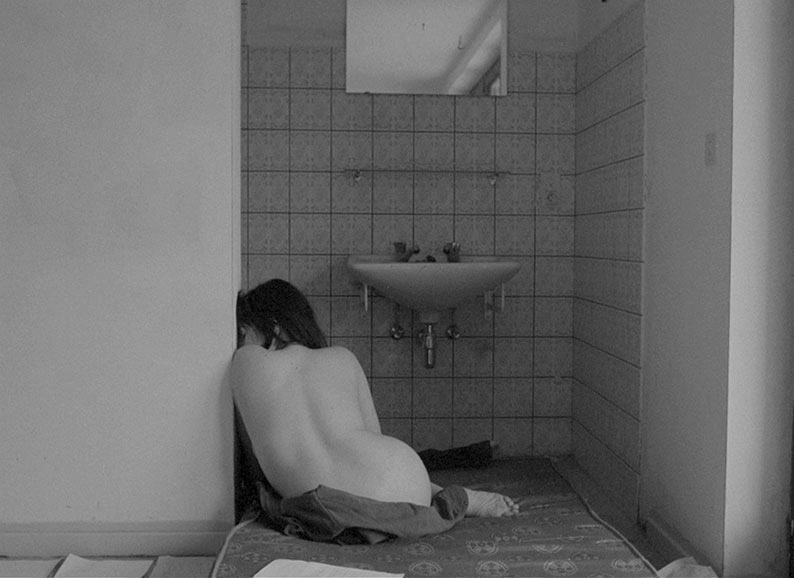
This is an essentially non-narrative film, but a closer look betrays a tighter structure. It is divided into three sections with a cast of three. There may be four pronouns in the title, but the title card arranges the two third-person pronouns together on one line. (They more or less correspond with the sections of the film, with the two encounters being the “il” and “elle”.) The film ends as Julie and her girlfriend make love, in a sequence of three long takes with a fixed camera. This was the first lesbian sex scene in a mainstream film, that is one not produced within the porn industry, and at some twelve minutes it remains one of the longest. Interestingly it does not seem to have attracted much in the way of censorship. The British Board of Film Censors (as was) passed it uncut. They no doubt did not have a choice, given that it would likely be down to passing the film without cuts or rejecting it entirely, and a non-narrative black and white subtitled film would never have played to a wide audience. Akerman shoots much of the film with a fixed camera, not in close-up and often at a lowish angle, a strategy she would develop further in Jeanne Dielman.
Je tu il elle had its first British showings in 1979, distributed by The Other Cinema, a non-profit organisation set up in 1970 which was devoted to non-mainstream, often experimental and often politically radical cinema, as often as not distributed in 16mm. (The BFI picked up Je tu il elle for 35mm distribution, which explains its being submitted to the BBFC.) The Other Cinema at London’s Institute of Contemporary Arts (ICA) showed a mini-retrospective of Akerman’s work that they were releasing, including Jeanne Dielman and News From Home. Akerman began shooting Jeanne Dielman on 27 January 1975, and that’s the film on Disc Three.
Je tu il elle is transferred from a 2K scan of the original 35mm and is presented in its original aspect ratio of 1.37:1.
| JEANNE DIELMAN 23, QUAI DU CAROSSE 1080 BRUXELLES |
|
Jeanne Dielman (Delphine Seyrig) is a widow, living with her son Sylvain (Jan Decorte) in an apartment in Brussels. We never hear her name – we only know it from the film’s title. Chantal Akerman’s film follows Jeanne through three days, as she cooks, cleans, shops, makes dinner for her son. And, in her afternoons, she receives clients as a prostitute.
Even before it won Sight & Sound’s poll, Jeanne Dielman’s influence had been widespread. To give just one example, Todd Haynes’s Safe is clearly indebted to its aesthetic strategies, such as its use of largely fixed cameras, head-on rather than to either side, in medium shot rather than close-up, from a slightly low angle. It’s not as low an angle as Ozu, say, often used, but low enough. Akerman said that the camera in Jeanne Dielman was at her own eye level, in other words that of an adult woman at the shorter end of average height, a little shorter than the 5’7” Seyrig. Much has been said about a film having a gaze, traditionally that of a man, looking at a woman, and the audience of the film looking too, said audience generally assumed to be largely male and heterosexual. So this is a film quite literally with a female gaze, not just that of the director but also the cinematographer (Babette Mangolte) and most though not all of the crew. And given the film’s prominence as a work of feminist cinema, maybe that of much of the audience too.
In this film, Akerman shows the influence of experimental filmmakers (the Canadian Michael Snow, for example) and brings their ideas of time, duration and cinematic space to bear on this film. Threes are significant again: three days (with a caption marking the end of days one and two), three “gentlemen callers”. Many scenes play out in real time, symmetrically composed that fixed low-angle camera, which never comes in for close-ups. Jeanne Dielman subverts the narrative model of other films. It foregrounds domestic scenes that other filmmakers would cut out entirely as unimportant and undramatic, such as cleaning the house, preparing and cooking food. While it does this, it elides what other films might see as dramatically significant. (Until the end of the film, all we see of Jeanne’s prostitution activities are the clients arriving – then, after a cut, leaving.) But these scenes, rituals even, need to be established so that we can tell when they begin to be disrupted, around the halfway mark. Jeanne gets up earlier than normal, which gives her extra time she does not know how to fill. She goes to shops before they are open. She leaves the lid off the vase where she keeps her prostitution takings. She lets the potatoes overcook. Her hair is out of place. These subtle signs of disturbance lead up to a finale that is unexpected but inevitable.
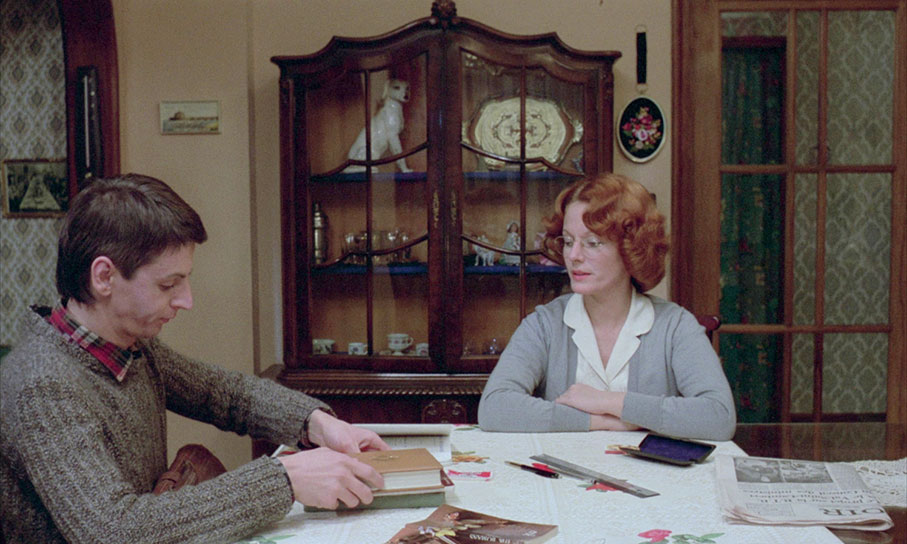
Jeanne Dielman runs 201 minutes. That’s more or less the running time of The Godfather Part II, Malcolm X and The Lord of the Rings: The Return of the King, and (without its intermission) The Brutalist, which is in UK cinemas and is an awards contender as I write this. Large-scale films, epic in approach and subject matter. Yet, in its way, Jeanne Dielman is an epic too, an epic of the quotidian and seemingly mundane: it asserts that this ordinary woman, and her life, is worthy subject matter for cinema, and for such an extended running time.
Akerman was only twenty-four when she directed Jeanne Dielman, and as she herself admitted, it had an impact which she never replicated. (Kate Rennebohm in her commentary on Les rendez-vous d’Anna, suggests that Akerman made other masterpieces, and she is not alone.) Delphine Seyrig is on screen throughout, intentionally deglamourised. It’s a remarkable performance, given that she has no dialogue for long stretches of the film. It’s a testament to her confidence in the young director that she, an established star by then, could devote herself so much to what was a low-budget film far off the usual beaten track. We’re never inside Jeanne’s head – although you could argue that the entire film is an expression of her state of mind – but the film’s pace allows us time to watch her, to take in the subtle shifts of her expression. Akerman's voice is heard as the off-screen neighbour whose baby Jeanne looks after – yet another gendered role for her.
Jeanne Dielman premiered at the 1975 Cannes Film Festival in Directors’ Fortnight. Akerman described how she and Seyrig were sitting at the back of the auditorium listening to the sound of seats flipping up as people walked out...but within days she was fielding some fifty offers for the film to play at film festivals around the world. One of them was Edinburgh later the same year, where it was shown twice for its British premiere. Jeanne Dielman didn’t receive actual distribution in the UK until January 1979 (reviewed in Time Out on the 19th of that month and in the Monthly Film Bulletin in April) in 16mm without a BBFC certificate, and featured in The Other Cinema’s ICA retrospective referred to above. Now, of course, its place in film history is secure, as the centrepiece of its director’s career and of this pair of Blu-ray box sets showcasing that career.
The Blu-ray transfer is based on a 4K scan and 2K restoration from the original 35mm negative and is presented in the intended ratio of 1.66:1. Colours are more pastel than they are elsewhere in the set, but this is certainly as I remember it looking, from that DVD in 2009 and a 35mm showing more recently.
On to Disc Four.
News from Home has its source in Akerman’s stay in New York City, but was actually made a few years later, shot in April-June 1976. So what seems freshly torn from her life is instead in retrospect, and as such is more than a little tinged in melancholy. What we see are views of the city in long takes, with Babette Mangolte again behind the 16mm camera. If Hôtel Monterey was entirely silent, giving its images an oneiric, almost almost abstract quality, here they are concrete, with the diegetic sounds of the city. Other than those, we have Akerman’s voiceover, reading letters that her mother sent her while she was staying. They are what you might expect from a mother looking out for the daughter she is clearly close to: in between family news are concerns that Akerman is well, is eating properly, that her new flat is what it should be and not in a dangerous area. Again, the film is technically documentary and is certainly a time capsule of a city in the mid-1970s, but again it is not. Akerman commented that everything is fiction even if it takes place in real time in front of a camera and might well have done if the camera were not there. Akerman’s own letters to her mother are not on the soundtrack so we are not party to her side of the exchange, but she’s there in the arrangement of what we see, and a sense that this city is overwhelming. In fact, that’s what it does, at the end of the film, as the street noises drown out her voiceover and reduces it to silence, as the camera takes a journey on the ferry, the vast buildings of New York receding into the distance.
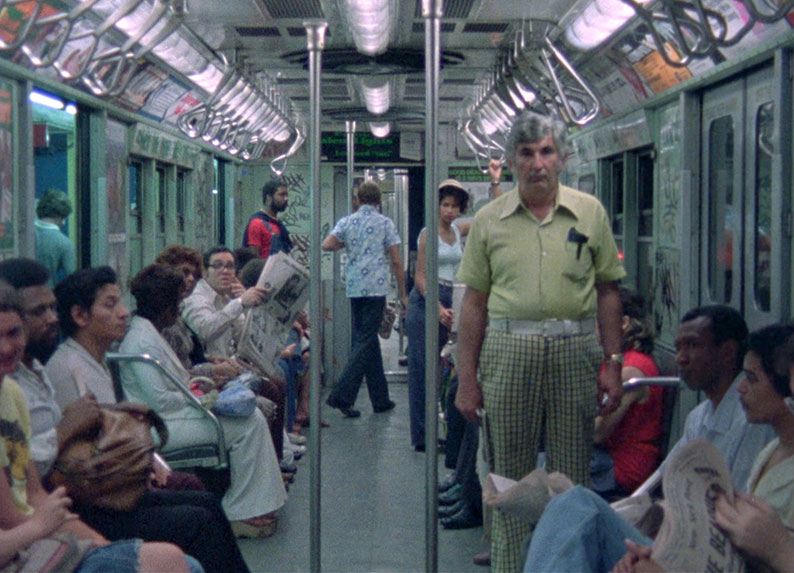
The film was made in two versions, with the voiceover in French or English, the pictures otherwise identical and the credits in French in both, other than the always-anglophone title. Along with Je tu il elle and Jeanne Dielman, News from Home was picked up for UK distribution in 16mm by The Other Cinema, in the English version.
News from Home is presented on this disc in its French and English versions, as separate transfers. They were derived from a 2K scan of a 16mm duplicate positive and is in the intended aspect ratio of 1.37:1. Given the 16mm origins and the likely use of available light, it looks fine, with some softness and notable grain due to the source.
Les rendez-vous d’Anna was Akerman’s first dramatic feature since Jeanne Dielman and has the sense of a film à clef, given Akerman’s own experiences touring the world’s film festivals with her much-fêted earlier work. The central character even has her middle name. Anne Silver (Aurore Clément, in the first of five collaborations with Akerman) is a film director travelling through Europe, through the then West Germany (Essen and Cologne) via Belgium (Brussels) and ending in France (Paris). Much of the film is devoted to her encounters with men and women along the way, including her mother (Lea Massari).
Jeanne Dielman took Akerman’s formal and narrative strategies to a likely limit, so there is a sense of a stepping back, a film still rooted in the same impulses and themes but taking them in different directions. Although it’s Jean Penzer as cinematographer rather than Babette Mangolte (again in 35mm), it’s clear the same director is in place from the opening shot, one of many symmetrically-composed shots of architecture, often with humans absent. In this case it’s a train station platform, with the entrance to a subway in the centre of the frame. The symmetry is broken by a train arriving at screen right, with passengers disembarking. One woman, Anne, is picked out by being the last on the platform, moving towards a phone box in long shot. Although it did step outside now and again, Jeanne Dielman was largely confined to Jeanne’s house and space, the address included in the full title. Anne has different spaces, transitory and liminal ones: trains, hotels. It’s a film about connections, making them, even if brief, breaking them, sometimes missing them. The protagonist’s flattened affect is shared by Clément’s very subtle performance and the film itself, often downplaying what would be emotional high points in other hands. The meeting and embrace of Anne and her mother, in the concourse of a large Brussels train station, happens in long shot.
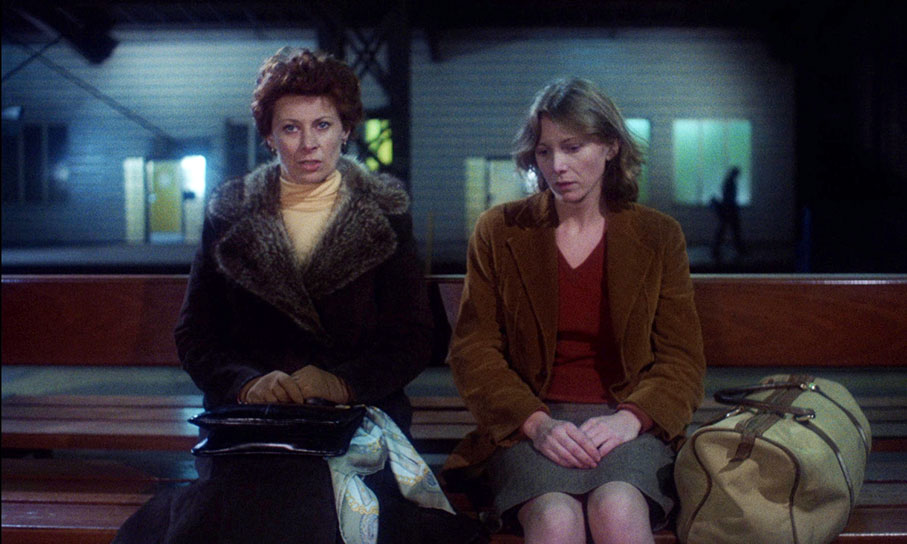
The camera is largely fixed, some tracking shots apart, and often when it does move it’s because it’s inside a moving vehicle such as a train or a car. Often in conversations Anne is talked at, often by men, but when she spends time with her mother, sharing a bed, the conversations are two-way, even to the extent of Anne talking about a sexual encounter with a woman, something her mother does not react to. At the end of the film, Anne is in bed, listening to messages on that index of late-twentieth-century isolation, the answering machine. She will no doubt be moving on soon, possibly to some of the festivals and appearances her publicist has lined up for her. As in the silent final shot of Jeanne Dielman, which held on Delphine Seyrig for some six minutes, Anne is alone.
Les rendez-vous d’Anna had a UK release in May 1980, distributed by The Other Cinema. As for the present box set, Les rendez-vous d’Anna is the only film in it to date to have been broadcast on British television, on Channel 4 on 2 January 1984, in that channel’s early-years “Eleventh Hour” slot on a Monday Night at that time, showcasing often radical and experimental work. Les rendez-vous d’Anna may not be quite that (Je tu il elle or Jeanne Dielman in that slot would have been quite something). Some reviews were disappointed, seeing the film as a retreat from Jeanne Dielman and a little self-indulgent. On the other hand, as Jill Forbes noted in the Monthly Film Bulletin (July 1980) it was Akerman’s most immediately accessible film to date – being an hour and a quarter shorter than Jeanne Dielman no doubt helped. In hindsight, it does see Akerman moving more into the mode of international arthouse cinema and away from her roots in experimental and structural film. Forbes concluded her review by calling the film “a summa of minimalism” and said that “what comes next will be fascinating”. For that we will have the second box set from the BFI.
Les rendez-vous d’Anna was scanned in 4K from the original 35mm camera negative and is presented in the aspect ratio of 1.66:1. No issues here, with the colours true and the image sharp and stable, with solid blacks and filmlike grain.
Chantal Akerman Volume 1 is a five-disc Blu-ray set released by the BFI. Volume 2 (also five discs) will follow in June 2025 and together will assemble the majority of Akerman’s films. The discs are encoded for Region B only. The first four comprise the films in the order I have reviewed them above. Other than the commentaries, all the extras in this set are on the fifth disc.
The set carries an 18 certificate, which is due to Je tu il elle, originally passed uncut at X in 1979. As mentioned above, Jeanne Dielman was originally released without being submitted to the BBFC but was passed at 15 in 2023. News from Home has a U certificate. Les rendez-vous d’Anna was a AA in 1980 and is now a 15. Other films do not appear on the BBFC website as I write this, though some of those are documentaries which would be exempted from classification.
[Update: Since this review appeared, most of the films have now been certified by the BBFC. The four INSAS films and La chambre are U. Saute ma ville a 15, L'enfant aimé... is PG and Les 15/8 a 12.]
The films were shot in a variety of formats and are presented in the appropriate aspect ratios. To avoid clutter I have detailed these at the end of each review.
Other than the ones which were silent and are presented mute, all the films in this set have monophonic soundtracks, which are rendered as LPCM 1.0. English subtitles are optionally available as appropriate. While the menu says that Saute ma ville is intended to be seen without subtitles, it does have some available, translating the title, dedication and subtitle (“Récit”), some words the young woman writes in the dust on a mirror and the spoken credits at the end. The English-language Les 15/8 has English hard-of-hearing subtitles available. News from Home is also indicated on the menu that it is meant to be viewed without subtitles, but they are available for the French version – not for the English, though.
Commentary on Saute ma ville by So Mayer and Selina Robertson
Recorded in 2024, this commentary features So Mayer and Selina Robertson, film critics and scholars and part of the film-showing collective Club des Femmes. Inevitably, given that this is a short film, it doesn’t leave much room for the two commentators, but they do cover quite a lot of ground, including Akerman’s themes and how they tie in with queer and feminist cinema of the time, with some excursions into theory. They also marvel at how clean Akerman’s kitchen is and note the Smurfs poster on the inside of the door, with its “Go Home” caption taking on disconcerting resonances in hindsight.
Commentary on Je tu il elle by So Mayer and Selina Robertson
Also recorded in 2024, Mayer and Robertsons commentary is along similar lines, but as they have a full-length feature to play with they are able to go into more detail, beginning with a deep dive as to when Je tu il elle was first shown in the UK (see above for more detail). Details noticed include the actual episode of Cannon which we hear on the soundtrack as Julie and the truck driver as they eat in a transport café. They do find a lot to talk about, with very few dead spots, and are not even lost for words during the twelve minutes of the sex scene, including comparisons to Barbara Hammer’s four-minute short Dyketactics, made the same year and equally groundbreaking as a film made about lesbian sexuality made by a lesbian. Regarding the other scene of a sexual nature, this was controversial in feminist circles and attracted walkouts at some showings.
Commentary on Jeanne Dielman by Kate Rennebohm and Simon Howell
Also newly recorded, this track is a multinational affair (Appleton, Wisconsin, and Toronto) from Kate Rennebohm and Simon Howell, who collaborated on The Akerman Year podcast, a series of twelve released between 2021 and 2023. Or rather this is newly rerecorded, as the first version was faulty, but they did not feel daunted by spending nearly seven hours talking about Akerman and her film. At one point, they say that they are referring to an AI-generated transcript of the first version, and have a laugh at some of the transcription errors – Akerman becoming “Aquaman” for example. With such a lot of time available, this conversation remains mainly tightly focussed, though isn’t very often scene-specific. They talk about the film being curiously timeless (superficial details like no smartphones notwithstanding) even if it is very much about time and duration, with the film’s long takes being cumulative rather than additive. News from Home is invoked, which leads to speculation that in some ways Jeanne Dielman the woman is Akerman’s view of her own mother. (Seyrig was born in 1932, so was of an age to have been Akerman’s mother.) In that light, it is interesting that Jeanne’s child, and presumably Chantal Akerman’s surrogate, is a boy and not a girl. This might well have changed the dynamic of the film entirely, as a girl would be expected to be trained to follow her mother into a role of femininity and domesticity, which a boy would not be. They also talk about Todd Haynes and how he directly evoked Jeanne Dielman in Safe. There is a lot to listen to here, but it’s an excellent commentary on a film which is not always easy to approach, however much it has been discussed in the last few years.
Commentary on Les rendez-vous d’Anna by Kate Rennebohm
Rennebohm again, on the only solo commentary on this set. Even accounting for the fact that she has a noticeably shorter film to contend with, she provides a commentary with few dead spots, along similar lines to her contributions to the Jeanne Dielman track. More specific themes dealt with here regarding Les rendez-vous d’Anna are the film’s autobiographical resonances and, with its wider range of locations, being a film of someone in transit rather than someone rooted to one place and one house. For example, the first man Anne meets is played by Helmut Griem, best known then for his role in Visconti’s The Damned, about a family of steel industrialists during the rise of Nazism – specifically in Essen, which is where Griem’s character takes Anne to visit. Rennebohm also pays much attention to Akerman’s style, with front-on symmetrical compositions much in evidence, and a mise-en-scène emphasising continuities rather than breaks. Even if this film is notably shorter, it is still over two hours, so there is a lot to be going on with in this commentary.
Chantal Akerman 1976: An Interview (50:48)
Shot on black and white video, this interview was conducted by B. Ruby Rich who remains onscreen with the camera fixed on Akerman. It is presented unedited, to the extent that Akerman’s microphone coming adrift leads to a brief cut and a continuation from another angle. Rich takes Akerman through her films to date, beginning with Saute ma ville, which Akerman says was undeniably ambitious, being shot in 35mm, though as she had the opportunity to do this she took it. That was in black and white, and she found the use of colour for the first time in a dramatic film, short or feature, in Jeanne Dielman, somewhat scary. Akerman does clear up an occasional inaccuracy, that Jeanne Dielman was originally even longer than it is. There was only ever the one version, at the present 201 minutes, eleven 35mm projection reels. (This misinformation may have come from the Monthly Film Bulletin, which gave the running time as 225 minutes when they reviewed the film, though they did correct this later.) Akerman’s script was very detailed, which Delphine Seyrig found restricted her, though there is more of this in the next item. Rich feels that Jeanne Dielman is the film where for Akerman form and content came together, and they discuss the film in the light of feminist thought of the time, such as the view that marriage in the nineteenth century was effectively prostitution.
Autour de Jeanne Dielman (68:54)
This was shot on videotape (again black and white) on the set of Jeanne Dielman by Sami Frey in January 1975. It was edited into its present form in 2004 by Agnès Ravez and Akerman, though there are plenty of tracking errors and dropouts inevitable given the lo-fi source, This is not so much fly-on-the-wall as those on screen are clearly aware of the presence of Frey and his camera, and Akerman addresses him directly at one point. Much of this involves Akerman and Delphine Seyrig sitting with the script and discussing the film and Seyrig’s role. Seyrig clearly found the very detailed script difficult, leaving little for her own input, even down to such small details about how she (and Jeanne) do their knitting. There is quite a lot of interest in seeing how a film like this was made, on a small budget and rather out of the mainstream, though which was still a professional production shot in 35mm.
Entretien avec ma mère, Natalia Akerman (29:33)
This was filmed in 2007, in Akerman’s mother’s kitchen with a static video camera. Akerman stays offscreen for the most part. Her questions were originally to be edited out, but keeping them in was the right decision, as the rapport between mother and daughter is very evident, and this conversation is very engaging. It is divided into captions, most of them the titles of Akerman’s films which they discuss. News from Home has a lot of attention, with Akerman senior admiring her daughter’s nerve in heading out to a new country, one where she didn’t even speak the language, at the start of her twenties, something she could never have done herself. The last named section is “What Do You Still Remember?” Although this is undeniably an attempt to capture testimony while people are still alive, Akerman junior still seems keen to establish her own record, often correcting her mother’s memories. She does this in the other interviews on this disc. This interview has a brief coda with Natalia Akerman still talking to camera, referring to her daughter in third person, as if the camera was some kind of confidante. Chantal Akerman would return to her mother for what would be her final film, No Home Movie, which we will see in Volume 2.
Entretien avec Babette Mangolte (34:07)
The cinematographer is interviewed in French, in an armchair, with a dog sitting on the sofa next to her and at one point leaving for something no doubt more engaging. Mangolte talks about how she and Akerman met in New York and became friends, often going to the same film shows. To her, life at the time was divided between the everyday things needed to live and survive and their creative lives, which for Mangolte was initially photography before becoming a camera operator on Yvonne Rainer’s film Lives of Performers (1972). She had not met Delphine Seyrig before working with her on Jeanne Dielman, but was, she says, “seduced by her professionalism” and it wasn’t until she saw the whole film on release that she was aware of her achievement. There was an age gap of some eight years between Mangolte and Akerman and hence a big/little sister vibe, though Mangolte does say that Akerman reminded her of her mother.
Aurore Clément et Les rendez-vous d’Anna(19:04)
As the title suggests, this interview is mostly about the one film of theirs which is included in this release, so maybe there will be more in Volume 2. This does bear out the sense that Les rendez-vous d’Anna has autobiographical resonances, as when casting the film she wanted someone who resembled her – specifically someone like her who was a brunette, though Clément’s hair is a lighter shade than Akerman’s. Clément had worked with Delphine Seyrig before so may have had been told some of her experiences on Jeanne Dielman. Much of the conversation is about Anne’s clothes and shoes as an indication of character. Clément also talks about Je tu il elle, which she found a revelatory experience.
Leaving Home: New World Vision (14:06)
This is a newly-produced video essay by Sarah Wood on News from Home, with new widescreen footage of the city, much of it shot CCTV from high above the streets, with the 16mm-derived 4:3 of the original film. Wood addresses Akerman from some five decades later, in a new century. This is specifically on 5 November 2024, a significant day for the USA as it was the presidential election with, as Wood puts it, a “choice between saving people from a burning building or pouring oil on the fire”. Wood investigates the interactions lost to time if captured on film. A group of people on a street corner seem to notice Akerman and Mangolte’s camera. Are they warning them away or inviting them across the street to join them? Was a woman sitting on the same street corner on a chair while people walk past posed? Akerman’s status as an observing outsider leaves her in a state of ambiguity.
Book
The BFI’s book, available with the first pressing of this set only, runs to sixty-eight numbered pages, plus covers. It begins, after a spoiler warning, with “Keeping a Distance” by Janet Bergstrom, reprinted from the November 1999 issue of Sight & Sound. Bergstrom cites a review from as far back as January 1976 (in Le Monde) which called Jeanne Dielman “the first masterpiece of the feminine in the history of the cinema”. However, Bergstrom goes on to say that this was not the only groundbreaking film that Akerman had made during that decade, and this and her other features became key texts in the development of feminist film theory, with debates drawing a distinction between realist and avant-garde filmmaking. Bergstrom discusses the ones of Akerman’s films in this set (not later) in some detail, as many of them would have been hard to see at the time and presumably unfamiliar.
Also from the Sight & Sound archive is “The Greatest Film of All Time”. This is from the issue (Winter 2022/3) which announced the results of the poll, and Laura Mulvey is the one to discuss the winner. She nails her colours to the mast in the opening paragraph: “For the first time in 70 years, the Sight & Sound poll has been topped by a film directed by a woman – and one that takes a consciously, radically feminist approach to cinema. Things will never be the same.” Indeed not. Not only was it the first film made by a woman to win, it was the first to make the top ten. (It ranked at number 35 in the 2012 poll.) Mulvey makes the point that Vertigo, which had won in 2012, had been “closing in” on Citizen Kane for decades before finally supplanting it, with the two being numbers two and three in 2022. However, both Hitchcock and Welles’s films were products of the Hollywood studio system, however ill-fitted they may seem, while Jeanne Dielman and Bicycle Thieves came out of a “movement”, in De Sica’s case Italian neo-realism. However, all four films display the use of the unconscious, especially in their cinematic styles. There’s something obsessive about all of them. Mulvey goes on to describe her first viewing of Jeanne Dielman, at the Edinburgh Film Festival in 1975, in a very fertile period for experimental cinema. Mulvey goes to say that there is a before an after for Jeanne Dielman, as there is for other great and groundbreaking films (including Citizen Kane), and quotes Akerman in saying, “At the age of 25, I was given to understand that I was a great filmmaker. It was pleasing, of course, but also troubling because I wondered how I could do better. And I don’t know if I have.” While acknowledging Akerman’s later works, Mulvey goes on to an analysis of the film at hand, with particular emphasis on the seven-minute final shot.
The rest of the booklet comprises new essays, on the films included in this set. So we have Lillian Crawford on the INSAS entry films, Catherine Bray on Saute ma ville, Diana Cipriano on L’enfant aimé… and La chambre, Justine Smith on Hôtel Monterey and Jeanne Dielman, Daniella Shreir on Hanging Out Yonkers, Pamela Hutchinson on Les 15/8, Jerry White on Je tu il elle, Sarah Wood on News from Home (see also Wood’s video essay in this set) and Hannah Strong on Les rendez-vous d’Anna, all dealing with their films in some depth. Usefully, the credits for each film also specify production dates and locations. Also in the book are notes on and credits for the extras and plenty of stills.
At the time of her death, Chantal Akerman’s status as a film director was as assured as it can be, even before Jeanne Dielman became consecrated as the greatest film of all time (until the 2032 poll comes along, anyway). She would have been seventy-five this year, with celebrations including the two Blu-ray box sets of which this the first. I can’t fault the presentation and the extras earn their place, particularly if you buy one of the first pressing and obtain a copy of the book. Volume 2 is due to be released as of this writing on 16 June 2025.
|